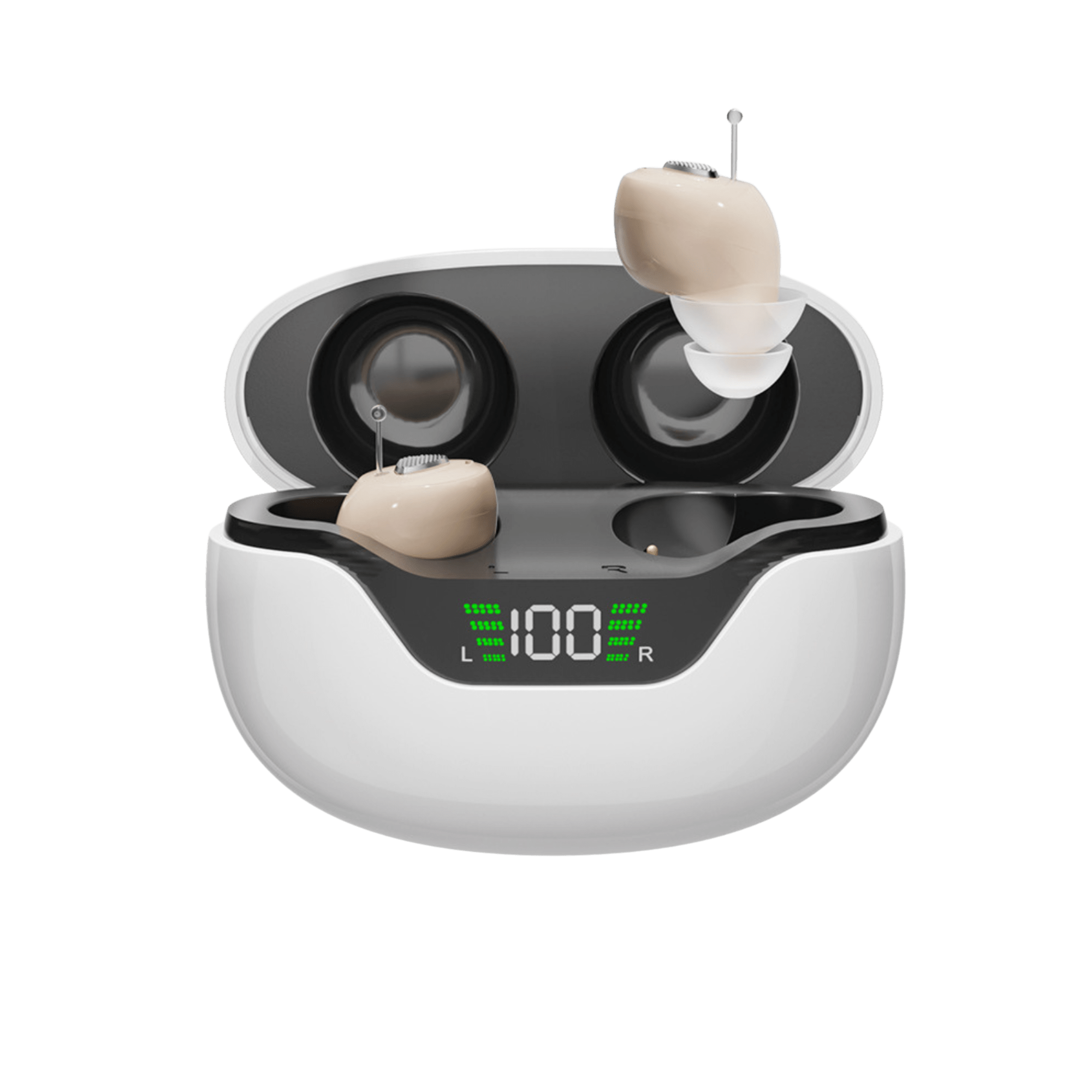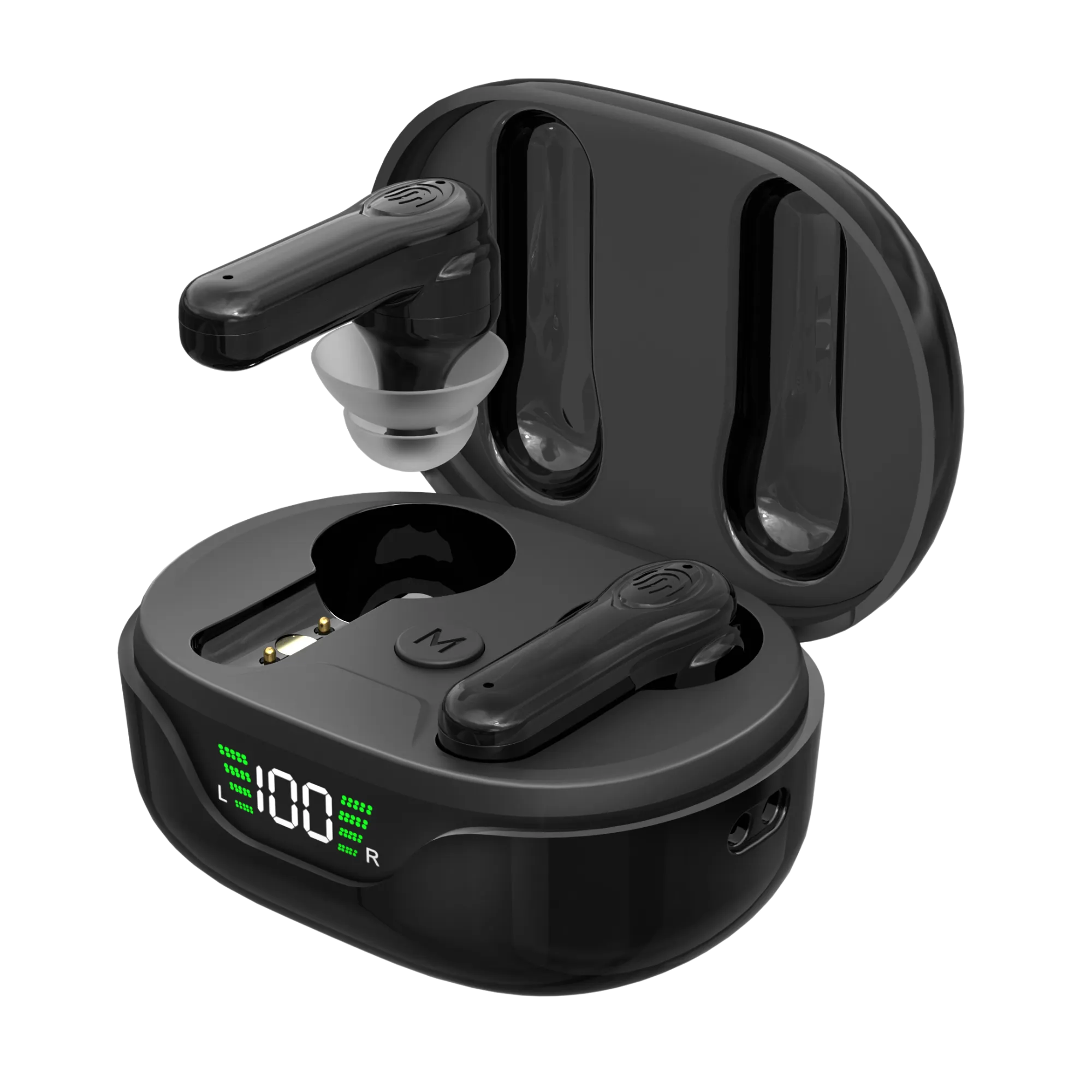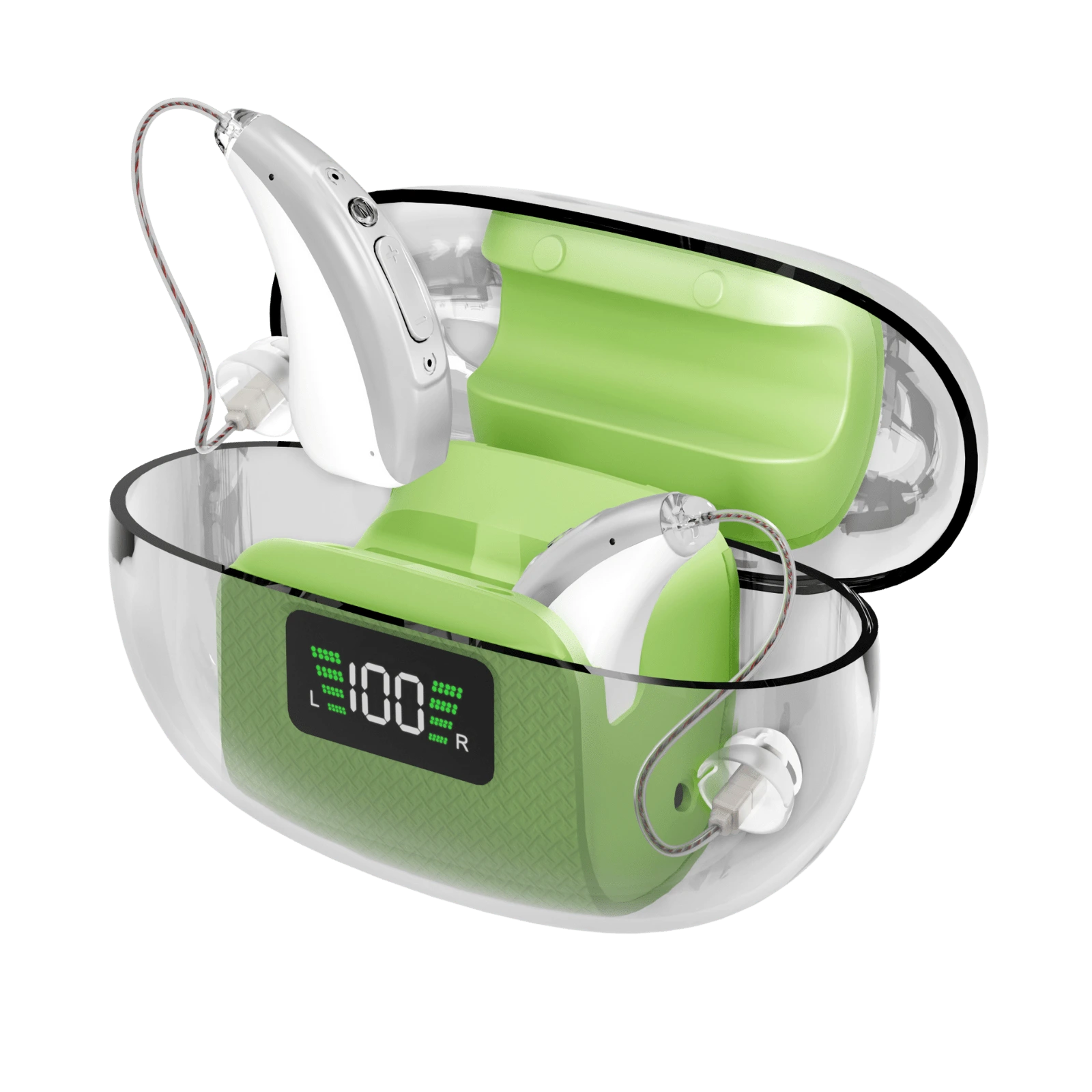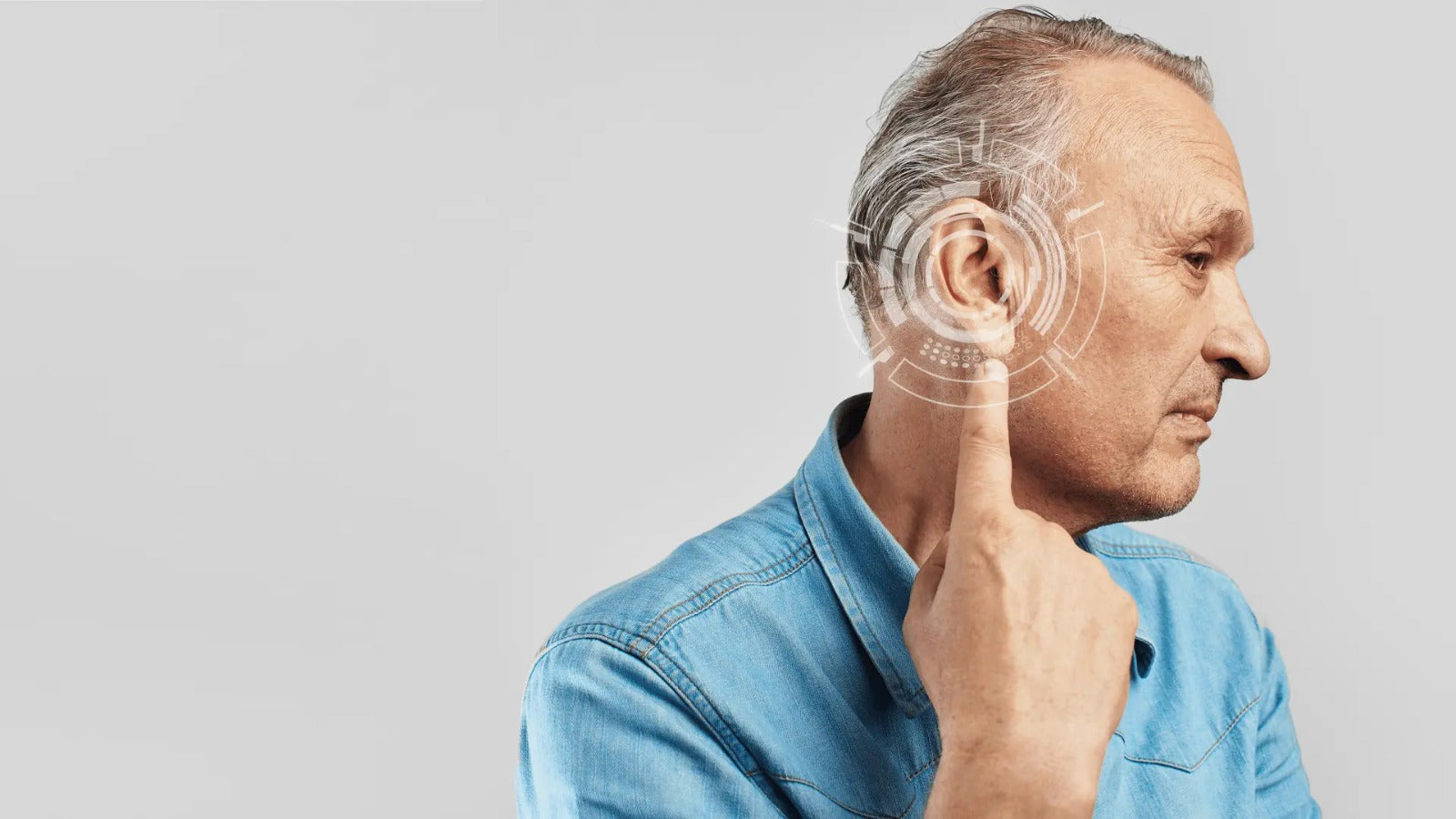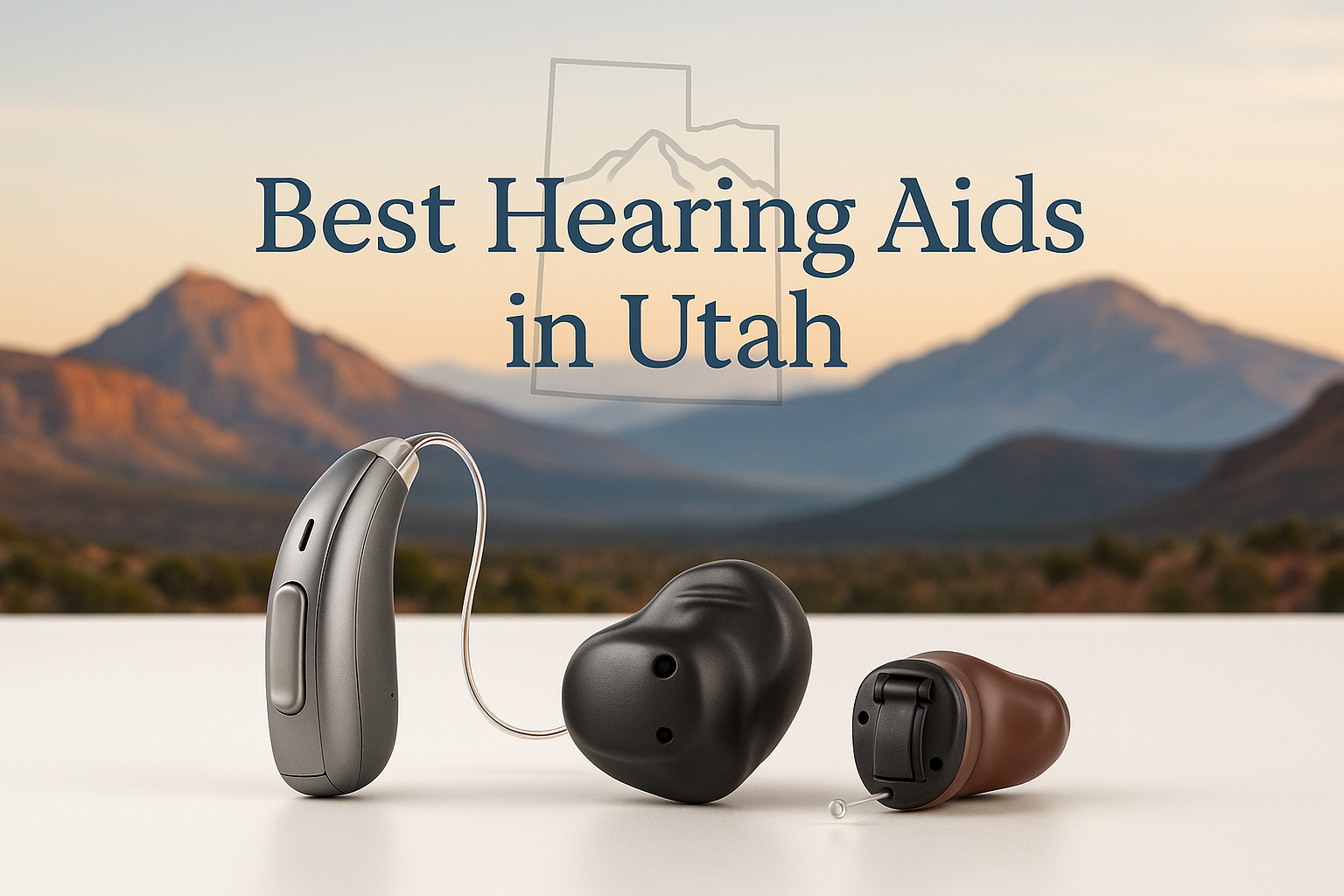TL;DR (Quick Overview)
-
Cost ranges: In Alabama, OTC hearing aids cost roughly $100-$1,000+ per pair (e.g. basic models ~$100; advanced Bluetooth OTC $1,000-2,000). Clinic-prescription aids typically run $2,500-7,000+ per pair including fitting and service. Fittings/add-ons can add $500-$1,500 more.
-
Differences (OTC vs Rx): OTC devices are sold directly for ages 18+ with self-fitting (no hearing test needed) and generally target mild-moderate loss. They include features like rechargeable batteries and smartphone apps. Prescription hearing aids require a professional audiologist fitting, serve any loss severity, and include follow-ups (often with Real-Ear Measurement to calibrate output). OTC are cheaper and convenient, but Rx aids offer more customization (audiogram matching, directional mics, etc.) for complex losses.
-
Trials & Returns: Most clinics offer ~30-60 day trials (some clinics give 60 days). Many OTC brands offer at least 60-day to 100-day trials or money-back guarantees. Return policies vary - Alabama has no specific state-mandated trial law, so ask each provider.
-
Alabama resources: State and federal programs can help. Alabama Medicaid covers hearing aids for children (<21) under EPSDT, but no adult benefit. Medicare generally does not cover hearing aids. Veterans get free hearing aids through the VA for qualifying vets. Alabama's Dept. of Rehabilitation Services (Deaf & Hard of Hearing Program) and programs like the Southern Disability Foundation loan program can assist low-income or disabled residents. Local HLAA (Hearing Loss Assoc.) chapters, state audiology board, and university clinics (UAB, Auburn, AUM) are key info sources.
-
Featured OTC - Panda Hearing Aids Quantum: The Panda Quantum is an OTC smart aid. It includes an automated hearing test, Bluetooth streaming, and a rechargeable case. It's appealing for tech-savvy users needing mild-moderate aid, costing about $349 (sale price; reg ~$499). It lacks professional fitting and might not suffice for severe or highly asymmetrical loss. Strengths: easy self-fitting via app, modern features (streaming, apps). Limitations: no live audiologist tuning, not ideal for kids or complex cases.
(Comparison infographic: OTC vs Prescription hearing aids - cost, fitting support, adjustments needed, medical oversight, trial-length, follow-ups)
How We Researched & Chose (Methodology)
We compiled information from state/federal health agencies, audiology associations, clinic sites, and consumer studies to ensure accuracy.
Inclusion criteria: We focused on licensed audiology clinics (cities' top clinics or university clinics), major OTC and prescription hearing aid brands with verifiable data (pricing, features, warranties), and programs for veterans or low-income. We prioritized current (2022-2025) info and multiple sources for key claims.
Evaluation factors: Devices were assessed on fitting/verification (e.g. real-ear measurement use for Rx aids), trial length, warranty (parts/labor, lost/stolen coverage), cost transparency (what's included), technology features (Bluetooth, noise reduction, rechargeability), and insurance eligibility (Medicare/Medicaid, VA). Clinics were evaluated on services (e.g. pediatric care, teleaudiology, evening hours) and participation in aid programs.
Conflict disclosure: Panda Hearing Aids (OTC) and local clinics are presented alongside peers. Any affiliation (e.g. affiliate/referral links) will be clearly disclosed; recommendations are based on objective criteria. All device and clinic info is sourced from public data.
(Flowchart: Our methodology - from gathering regulations and pricing data, evaluating devices and clinics, to synthesizing recommendations.)
Recommendation Matrix (User Profile → Best Path)
| User Profile / Need | Best Path | Est. Cost & Notes | Trial / Fit Time |
|---|---|---|---|
| Mild-Moderate, budget-focused adult | OTC hearing aid (e.g. Panda Quantum, Lexie, Audien) | OTC ~$100-1,500/pair (devices only); no fitting fees. May need remote support. | Typically 60-100 day return policy |
| Active senior / veteran needing aid | VA audiology or clinic Rx aids | VA: $0 for veterans. Clinic: ~$3,000-7,000/pair including fitting. Medicare does not cover hearing aids. Many VA clinics also coordinate outside referrals. | Clinic fittings take ~1-2 visits; trial ~30-60 days |
| Severe loss or complex hearing profile | Prescription hearing aids (clinician-fitted) | $5,000-7,000+/pair at full service clinic. Insurance rarely covers. | Professional fitting (REM, audiogram) needed; trial ~30-60 days |
| Tech-savvy adult wanting DIY solution | Premium OTC (e.g. Jabra Enhance, Lexie) | Premium OTC ~$1,000-2,000/pair. All apps/self-fit. | Same 60-100 day trial as above. |
| Pediatric / any red-flag conditions | Referral to audiologist/ENT | Clinical path (FDA warns: "do not self-fit" if red flags like asymmetry, pain, sudden loss). | Clinical eval before any hearing aids. |
Notes: Asymmetric or sudden loss, severe tinnitus, ear pain/drainage etc. always warrant medical exam. OTC aids are not recommended for children or suspected conductive loss. Veterans should first explore VA benefits (often free). Confidence varies by scenario: OTC is riskier for medical issues; clinic path is costlier but safer for complex cases.
(Decision-tree visual: Mild/moderate loss → consider OTC; severe/medical flags or child → audiologist; veterans → VA pathway.)
Top Hearing Aid Picks (OTC + Prescription)
Panda Hearing Aids Quantum (OTC)
Best for: Adults (18+) with mild-moderate loss who want an easy self-fit device. Good for first-time users and Bluetooth streaming.
Key features: Automated hearing test and tuning via smartphone app; Bluetooth streaming/music/phone; rechargeable charging case (holds multiple charges); feedback suppression, noise reduction; small behind-the-ear form factor.
Price: ~$349/pair (on sale; reg ~$499). Includes device pair, charger, common-size tips. (No clinic fees since OTC.)
Trial & Return: Panda offers a 60-day money-back trial. If unsatisfied, full refund minus return shipping.
Warranty & Support: 1-year manufacturer warranty on defects. (No in-person service; support via phone/chat.) No lost/stolen coverage.
Where to buy: Direct from Panda's website and authorized vendors. Eligible for HSA/FSA; veterans can purchase OTC as needed.
Limitations: Lacks clinical fitting - may not fully address severe loss or complex audiograms. Less effective in very noisy environments or if losses differ greatly between ears. Not for children or ear medical issues. Some users may need professional fine-tuning (not available with OTC).
Quick review: Users report the Quantum is sleek and rechargeable with clear sound for quiet situations; convenient for media streaming. It performed well in basic user tests, though lab tests find clinic aids still surpass it in noise performance (as expected). Good entry-level OTC performance.
Other OTC Recommendations
-
Lexie (OTC): Around $499-999 per pair. Behind-the-ear style with remote hearing test and app. 45-day trial. Rechargeable/power options. Good for mild loss. (Budget, easy service via online audiologists.)
-
Jabra Enhance (OTC): Advanced Bluetooth-enabled aids (~$995-$1,995/pair). Features wireless multi-microphone streaming, rapid charging. 100-day trial. Self-fit or optional professional tuning. Strong for tech-savvy.
-
Audien (OTC basic models): Entry-level rechargeable OTC options, with prices starting very low for basic amplification, suitable for mild loss.
(Visual: Panda Quantum device with labeled features - app on phone, charging case, Bluetooth icon, size comparison.)
(Visual: Side-by-side OTC models - Panda vs Lexie vs Jabra - showing ear-form factor, case, smartphone interface, approximate price tags.)
Prescription/Clinic-Fitted Picks
-
Phonak (e.g. Phonak Audeo Life/Paradise): Premium BTE aids. Features top-tier noise reduction, rechargeable options, and universal Bluetooth (connect to any device). Cost ~$5,000-7,000/pair at clinics. Supports severe loss. Clinics often include 2-3 years of batteries, repairs, and follow-ups. Trial ~30-60 days. (Warranty ~3 yrs, lost/stolen optional add-on.)
-
Oticon (e.g. Oticon More/Real): Competes with Phonak. Emphasizes brain-oriented processing, advanced feedback cancellation. Similar pricing (~$5k-7k) and service. All high-end Rx aids have comparable features (directional mics, tinnitus masking programs, multi-channel DSP).
These are sold only via audiologists/ENTs. Example: University clinics and reputable private clinics dispense Phonak, Oticon, GN ReSound, etc. Clinics include Real-Ear Verification, custom molds, and multiple adjustments.
Warranty & Support: Typically 3-year manufacturer warranty (parts & repair). Most clinics offer at least 1 year of free follow-ups and cleanings. Lost/stolen coverage varies (often $500-$1,000 replacement fee). 30-90 day total or 2-cycle refund policy is common.
Limitations: High cost, requires several clinic visits. Not self-service. Some patients note over-amplification risk or needing multiple adjustments. These are not OTC legal devices; no returns after fitting.
(Visual: Clinic-fitted vs OTC visual: side-by-side images of a hearing aid from an audiologist's kit (with tubing, earmold) vs a sleek OTC aid and apps/icons for adjustability, with icons highlighting differences (cost, visits vs self-fit, etc.).)
City-by-City Mini-Guides (Selected Alabama Cities)
For each city listed below, we include notable clinics and a brief summary. Pricing and detailed trial policies are often not published; where unavailable, we flag that the info could not be verified online and advise calling the clinic.
Cities covered: Birmingham, Mobile, Huntsville, Montgomery, Tuscaloosa, Hoover, Dothan, Auburn, Decatur, Florence, plus regional centers where relevant.
(For brevity here we keep the clinic list but without clickable links - full CSV available on request.)
-
Birmingham: Multiple university and private clinics (university teaching clinic, ENT audiology practices, private audiology centers). Typical services: diagnostics, hearing aid fitting, REM verification at major clinics. Trial periods commonly 30-60 days; pricing varies widely by device and service level.
-
Mobile: University speech & hearing clinic (teaching clinic), ENT groups with audiology, private hearing centers. USA Health teaching clinic provides low-cost evaluations for students and supervised fittings.
-
Huntsville: Several private audiology clinics and VA outpatient audiology services; VA clinics provide free hearing aids to eligible veterans.
-
Montgomery: University-affiliated clinics, ENT groups, and private audiology practices. AUM and other university clinics often have student-supervised services at reduced fees.
-
Tuscaloosa: ENTs and private audiology centers; some clinics advertise 60-day trials and financing options.
-
Hoover: Suburban clinics and ENT practices with audiologists on staff.
-
Dothan: Regional auditory providers and private clinics offering standard services.
-
Auburn: Auburn University Speech & Hearing Clinic offers supervised services and may offer lower-cost options.
-
Decatur & Florence (The Shoals): Regional branches of larger Alabama audiology groups and private clinics; some university-affiliated options nearby.
-
Veteran services: VA audiology services exist in Birmingham, Tuscaloosa, Huntsville, Mobile, and other areas - veterans should check eligibility with their local VA.
Downloadable CSV of clinics: If you'd like the full clinic CSV (Name, Address, Phone, Website, Services, Veteran/Subsidy flag where known) as a downloadable file, tell me your preferred format and I'll prepare it.
(Map graphic: Locations of listed clinics across Alabama.)
State Laws & Licensing (Alabama-specific)
-
Licensing body: The Alabama Board of Examiners in Speech-Language Pathology & Audiology (ABESPA) regulates audiologists and hearing instrument dispensers. Licensed Audiologists typically hold an Au.D. and meet required supervised practice hours; Hearing Instrument Dispensers have a board-approved path and exams. Continuing education is required periodically for license renewal.
-
Consumer protections: Alabama does not mandate a specific trial period for hearing aids. Most clinics voluntarily offer 30-60 day satisfaction/return periods. For consumer protection and dispute resolution, the licensing board handles complaints against practitioners.
-
FDA & OTC regulation: The FDA's OTC hearing aid rule (effective Oct 2022) permits OTC sales for adults with perceived mild-moderate hearing loss. Alabama has no additional statewide prohibitions on OTC devices.
-
Teleaudiology: Tele-audiology/remote fittings are allowed in Alabama, but providers must be appropriately licensed in the state. Many clinics offer remote fine-tuning as part of follow-up services.
-
Medical red-flags requiring referral: Sudden hearing loss, ear pain or drainage, persistent unilateral tinnitus, dizziness/vertigo, asymmetrical hearing loss, visible ear canal obstruction or deformity. These should be evaluated by a physician (ENT) prior to hearing aid fitting.
(Infographic: red-flag checklist: sudden hearing loss, tinnitus, ear drainage, pain, asymmetry, vertigo, balance issues.)
Costs, Insurance & Assistance (Alabama)
-
Typical cost bands:
-
OTC entry-level: ~$100-300 per pair
-
OTC premium: ~$500-1,995 per pair
-
Clinic-fitted basic Rx: ~$2,500-4,000/pair (often includes some follow-ups)
-
Clinic-fitted premium Rx: ~$5,000-7,000+/pair (full service with REM and extended warranty)
-
-
Medicare: Medicare Part A/B does not pay for hearing aids or routine hearing exams. Some Medicare Advantage plans may include limited hearing benefits - check your plan details.
-
Alabama Medicaid: Covers hearing aids for children under 21 under EPSDT; adult hearing aids are generally not covered.
-
VA & TRICARE: VA provides hearing aids, batteries, and repairs at no cost to eligible veterans. TRICARE coverage varies - active-duty dependents may have options via military audiology services.
-
FSA/HSA: Hearing aids and related fitting or repair services are typically eligible medical expenses under FSA/HSA rules - keep receipts and documentation.
-
Financing: Common options are CareCredit, in-house clinic financing, and low-interest loans (nonprofit programs). Some clinics may offer promotional 0% interest plans for a set period.
-
Hidden costs to watch for: Additional visits beyond included follow-ups, batteries or charging accessories, lost/stolen replacement fees, optional warranty extensions, shipping, and accessory purchases.
(Bar chart: cost ranges - OTC entry, OTC premium, clinic-fitted basic, clinic-fitted premium; overlay typical offsets like VA and Medicaid child coverage.)
(Icon set: FSA/HSA, financing badges, VA emblem, Medicaid shield, Medicare symbol - short captions about coverage.)
Buyer's Roadmap & Checklists
Step-by-step journey: screening → research → purchase → fitting → trial → adjustments → maintenance → upgrades → long-term follow-ups.
Printable checklist includes: red-flag reminders, questions to ask clinics, warranty checks, financing options, maintenance schedule, and a compact timeline for follow-ups and annual checks.
(Journey flowchart visual: screening → decision → purchase → fit → trial → adjust → maintain → upgrade.)
Resources for Alabama Residents (Select)
-
Alabama Department of Rehabilitation Services - Deaf & Hard of Hearing Program (state referrals and services information)
-
Alabama Board of Examiners in Speech-Language Pathology & Audiology - licensing and complaint resources
-
University audiology / teaching clinics: UAB Audiology Clinic, Auburn University Speech & Hearing Clinic, AUM Speech & Hearing Clinic, University of South Alabama Speech & Hearing Center
-
VA Medical Centers and Outpatient Clinics - provide audiology and free hearing aids for eligible veterans
-
Hearing Loss Association of America - Alabama chapters (support groups and advocacy)
-
Nonprofits & loans: Southern Disability Foundation (Ability Loan), local Lions Clubs (screenings and limited assistance), local charities offering grants or loaner devices
(Each resource name is shown plainly - contact details and eligibility requirements are available from the organizations directly.)
FAQ (Selected Questions & Answers)
-
Are OTC hearing aids legal and widely available in Alabama?Yes. FDA regulations permit OTC hearing aids for adults with perceived mild-moderate hearing loss, and they are sold in Alabama.
-
When should I see a licensed audiologist or physician?See an audiologist/physician if you have red-flag symptoms: sudden hearing loss, ear pain/drainage, dizziness/vertigo, unilateral tinnitus, or if you are under 18.
-
What does Medicare cover?Medicare typically does not cover hearing aids. Some Medicare Advantage plans may offer limited hearing benefits; verify with your plan.
-
What is Real-Ear Measurement (REM)?REM is an objective verification procedure that measures actual sound in your ear canal when wearing hearing aids, ensuring prescribed amplification is delivered.
-
Can I use FSA/HSA for hearing aids?Yes, hearing aids and related fittings and repairs are generally eligible medical expenses under FSA/HSA rules.
-
How to choose rechargeable vs disposable-battery aids?Rechargeable aids reduce recurring battery cost and are easier for many users; disposable batteries are convenient for travel and backup.
-
Are remote adjustments legal/available in Alabama?Yes - remote tuning is legal if the provider is licensed in Alabama. Many clinics now offer teleaudiology services.
(Full FAQ in the guide includes 10-15 questions tailored to Alabama residents and repeats the key legal/coverage points above.)
Glossary (Select Terms)
-
Audiogram: Chart showing hearing thresholds across frequencies.
-
Decibel (dB): Unit measuring sound level; used to categorize hearing-loss severity.
-
REM (Real-Ear Measurement): Verification that a hearing aid's output in the ear matches prescribed amplification.
-
Occlusion effect: The sensation of one's voice sounding "boomy" with an in-ear device.
-
Tinnitus: Perception of noise or ringing in the ears without external sound.
-
Directional microphone: Microphone that focuses on sounds in front of the wearer to improve understanding in noisy settings.
-
RIC / BTE / ITE / CIC / IIC: Common hearing aid form factors (Receiver-in-Canal, Behind-the-Ear, In-the-Ear, Completely-in-Canal, Invisible-in-Canal).
-
FSA/HSA: Tax-advantaged medical accounts used to pay for eligible health expenses, including hearing aids and services.
(Glossary includes plain-language definitions and alt-text for diagrams used in the complete guide.)
Accessibility & Downloads
-
Printer-friendly PDF (2 pages): Key takeaways, quick checklist, cost bands, red-flags summary, and resource highlights - available on request in your preferred file format.
-
Clinic CSV: Full clinic listing in CSV format (Name, Address, Phone, Website, Services, Veteran/Subsidy flag) - available on request.
All visuals include alt-text and are designed to be mobile-friendly and legible when printed.
Disclaimers & Compliance
Medical disclaimer: This article is for informational purposes only and does not constitute medical advice. Always consult a licensed audiologist or physician for diagnosis, medical evaluation, or fitting.
Affiliations & disclosure: Panda Hearing Aids (Quantum) is featured among other devices. Some links in the original published guide may be affiliate/referral links; this document intentionally displays source names without hyperlinks as you requested. Recommendations are based on objective criteria and publicly verifiable data.
Last verified: October 2025. Verify trial periods, pricing, and coverage with manufacturers and clinics directly.
References (cleaned; links removed as requested - source names visible)
-
FDA / NIDCD - "Over-the-Counter Hearing Aids: What You Should Know" (Oct 2022). Source: U.S. Food & Drug Administration; National Institute on Deafness and Other Communication Disorders.
-
FDA - "Hearing Aid Benefits and Limitations" (Aug 2017). Source: U.S. Food & Drug Administration.
-
American Academy of Otolaryngology-Head and Neck Surgery - "Red Flags - Warning Signs of Ear Disease" (2018). Source: AAO-HNS.
-
HealthyHearing.com - "OTC vs Prescription Hearing Aids: Pros & Cons" (2020). Source: HealthyHearing.
-
National Council on Aging (ncoa.org) - "Jabra Enhance OTC Hearing Aids" (2023). Source: National Council on Aging.
-
HearingTracker - "Lexie Hearing Aids Review" (2024). Source: HearingTracker.
-
Product literature / vendor pages - Audien OTC hearing aid product info (2023). Source: vendor product pages and published specs.
-
Industry comparisons - "Phonak vs Oticon Hearing Aids" (2023). Source: industry reviews and audiology trade analyses.
-
Alabama Medicaid policy notes (publicly available state policy summaries) - Medicaid EPSDT coverage for children (2022-2024 summaries). Source: Alabama Medicaid policy documents and state guidance.
-
Alabama Hearing Associates (clinic resources and commentary) - "Are Hearing Aids Covered by Insurance?" (Mar 2023). Source: Alabama Hearing Associates.
-
Tuscaloosa ENT - clinic website information on trial periods and services. Source: Tuscaloosa ENT clinic website and published consumer materials.
-
UAB Medicine - Audiology & Hearing Aids information; UAB Otolaryngology department clinic summaries. Source: UAB Medicine audiology service pages.
-
U.S. Department of Veterans Affairs (VA) - "VA Hearing Aids - Access and Benefits" (current VA policy summaries). Source: VA informational materials.
-
IRS Publication 502 - "Medical and Dental Expenses" (2023). Source: IRS guidance on qualified medical expenses (FSA/HSA eligibility).
-
Panda Hearing Aids - Panda Quantum product page and published features (vendor product materials and product spec sheets). Source: Panda Hearing Aids official product documentation.
-
Industry infographic and trade summaries - "OTC vs Prescription Hearing Aids" (2022-2024). Source: industry white papers and trade organizations.

